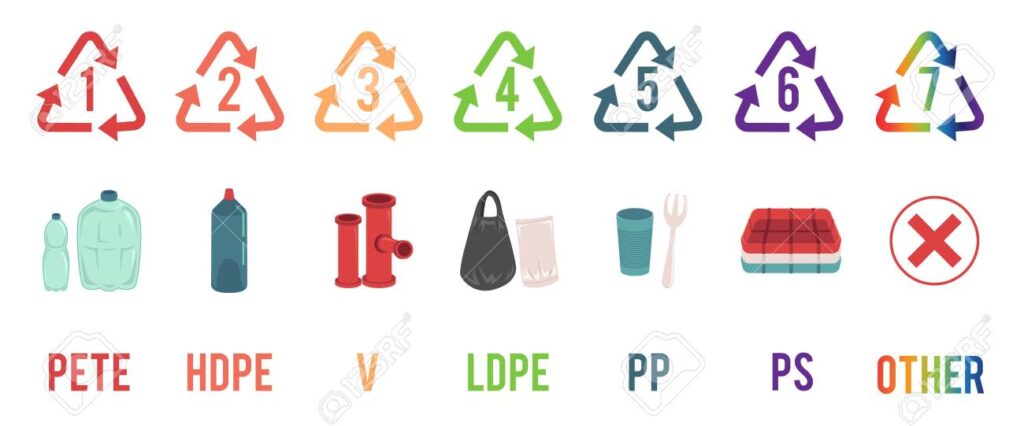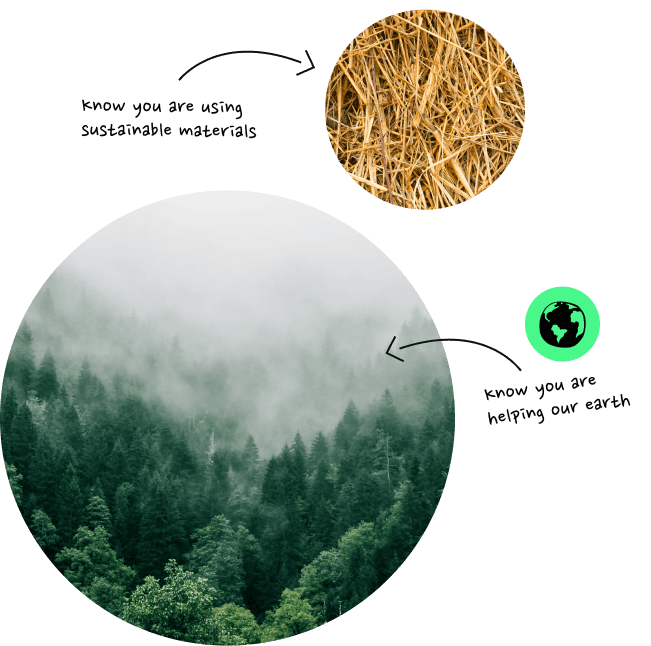We know plastic when we see it or touch it. We also know that they are all slightly different. What you might not understand it that plastics recycling requires specific separation and processing. A water bottle, a milk jug, and an iced coffee bottle all have the same function but are likely made from different plastics. To help identify each type, you can look for the resin identification code (RIC). It is a small symbol, which you have most likely seen as a small number within the recycling symbol’s 3 chasing arrows. Here’s a quick overview of each plastic type, where they are most commonly used, their reusability, recyclability and toxin leaching potential.

Plastic Type #1: PETE/PET (Polyethylene Terephthalate)
Most commonly seen as: bottled beverages like water and soda.
Reusability: ★☆☆☆☆
Recyclability: ★★★★☆
Toxin leaching: ★★☆☆☆
PET’s chemical structure means that it is not strongly held together which makes it an easily recyclable material. Larger PET items are easily recycled into polyester fibres used in clothing, giving PET a high waste value. This makes it the most widely recycled plastic globally. The material’s loose structure also means that it tends to fragment, allowing bacteria to accumulate which can lead to plastic leaching.
Plastic Type #2: HDPE (High Density Polyethylene)
Most commonly seen as: household cleaning product bottles, milk jugs, flexible piping
Reusability: ★★★★☆
Recyclability: ★★★☆☆
Toxin leaching: ★★★☆☆
A cheap and more “heavy-duty” plastic, HDPE has high strength and solvent resistance. Because of this, it has a lower propensity to leach toxins. It is widely recycled, but not to the same extent as PET.
Plastic Type #3: PVC (Vinyl)
Most commonly seen as: construction pipes, window frames, electric cable insulation
Reusability: ★★★★☆
Recyclability: ★☆☆☆☆
Toxin leaching: ★☆☆☆☆
One of the worst plastic choices around. Depending on the end use, the raw material is incorporated with toxic additives such as heat stabilizers, UV stabilizers, plasticizers, processing aids, impact modifiers, thermal modifiers, fillers, flame retardants, biocides, blowing agents or smoke suppressors which leach easily. Further to the additives, its high chlorine content makes it hazardous to recycle.
Plastic Type #4: LDPE (Low Density Polyethylene)
Most commonly seen as: plastic films or sheets, such as shopping bags, foodwrap and labels.
Reusability: ★★★☆☆
Recyclability: ★☆☆☆☆
Toxin leaching: ★★★☆☆
Is a flexible and tough material with high chemical resistance. Very reusable, but commonly recycled as it tends to become clogged in mechanical recycling machinery. On exposure to sunlight, LDPE begins to fragment, emitting two potent greenhouse gases: methane and ethylene.
Plastic Type #5: PP (Polypropylene)
Most commonly seen as: takeaway food containers, food sauce bottles, bottle caps
Reusability: ★★★★☆
Recyclability: ★★★☆☆
Toxin leaching: ★★★☆☆
Polypropylene is the second most-produced plastic globally. Tough, flexible and light with good resistance to heat and mechanical fatigue.
Plastic Type #6: PS (Polystyrene)
Most commonly seen as: food containers and hot cups (as styrofoam), pens
Reusability: ★★★☆☆
Recyclability: ★☆☆☆☆
Toxin leaching: ★★☆☆☆
Extremely difficult to recycle and contains several toxic chemical additives. It’s styrofoam form is particularly prone to fragment and create microplastics, leading to it being banned in several countries.
Plastic Type #7: Others
A catch-all for other plastics manufactured. Extremely unlikely to be recycled as many plastics will be mixed together in waste streams. Some of the most common examples are:
- Polycarbonate (PC) – tough with high clarity. Frequently contains BPA or BPA derivatives such as BPS which are detrimental to human health. Common uses include drinkware, glasses lenses.
- Polyurethane (PU) – a broad class of plastics. Common uses include rigid and flexible foams, varnishes and coatings, adhesives.
- Polylactic acid (PLA) – produced from renewable (often biobased/plant-based) resources, it is able to degrade when industrially composted. Common uses include packaging, takeaway containers, medical implants.
- Acrylonitrile butadiene styrene (ABS) – impact resistance, toughness, and rigidity. Lego bricks, car trims, musical instruments.
Plastics recycling can’t account for forever materials
Plastics recycling has existed for over 50 years, in which time only 9% has ever been recycled. More has been incinerated over the same period. The problem with plastic recycling is the process itself. Plastic is recycled mechanically, meaning that the waste is separated, cleaned, and then shredded before being reformed into pellets. This process shortens the polymer chains, which makes the resulting material less strong and resilient. This affects the continued viability for 3 reasons:
Economic
High production costs and low-value products squeeze recyclers from both sides, meaning very thin margins. Recyclers are simply unable to reliably sell their product or operate profitably.
Technical
As a weaker material, recycled content must be mixed with virgin material to meet performance, limiting market demand for recycled content.
Environmental
Plastics recycling is limited, as most can, realistically, only be repurposed once – downcycled into fibres for yarns and fillers. Once these new products have reached the end of life, the plastic will continue to persist in the environment. Synthetic fibres also release microfibres, which pass through filters and enter the water systems.
Chemical recycling is a new technology that doesn’t suffer from creating shorter polymer chains. However, it is yet to be proven at scale and currently requires such large amounts of energy that it is neither economically viable nor environmentally positive.
Final Thoughts
The best approach to plastics recycling is to minimise the production of new virgin ‘forever’ plastic material, relying where we can on making use of existing materials in the economy – i.e. recycled content. “Recyclable” labels give no guarantee that the products will actually be recycled. We must not allow it to be the sustainability end-goal.
Lead photo by mali maeder from Pexels.






